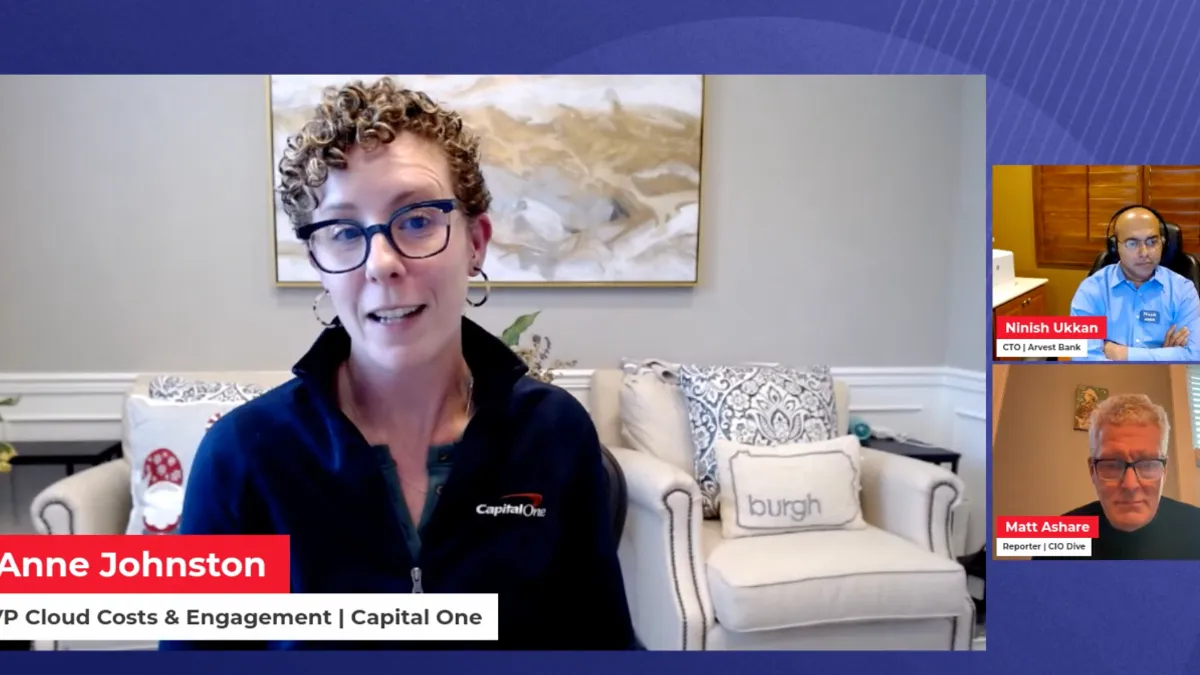The cloud is key to enterprise IT, supporting customer-facing applications and the tools employees need for their daily work. But agility and scalability gains can lead to eye-watering bills from providers.
More than half of companies say they've faced higher cloud costs this year, according to Vertice data. And Gartner projections say end-user spending on public cloud is set to grow more than 20.4% next year, reaching $678.8 billion.
Despite the sticker shock, organizations seek cloud implementations that can enhance how they do business.
For Capital One, initial migrations have since given way to a more value-driven strategic approach, according to Anne Johnston, VP, cloud costs and engagement at Capital One.
"Cost isn't a hindrance," said Johnston, speaking Dec. 6 during a CIO Dive virtual event. "But it really helps you create opportunity for investments, which is where innovation comes and allows our engineers to really be creative with their solutions."
Arvest Bank is earlier on in its cloud journey. Though it hasn't grappled with runaway spending, the company has set controlling costs as a long term goal, according to CTO Ninish Ukkan, speaking during the same panel.
"We're in the process of setting up FinOps to optimize our spend," said Ukkan, in reference to the IT framework that seeks to maximize the value of cloud. "As we mature in our cloud practice, we use tools like Apptio to do the same."
With the right procedures in place, organizations can curb cloud waste without stifling innovation. A combination of skill building, software tools and planning let the two companies gain transparency and control over cloud costs.
Training, tools and community
Executives looking to gain control over cloud spending are not alone.
More than two-thirds of IT leaders say public cloud is a potential source of software spending waste, Flexera data show. Dollars spent aren't always converted into compute, either, as companies globally sit on more than $300 billion in untapped cloud credits, according to Infosys.
Cost management starts with people, according to Johnston.
"We've really invested in our people, from developing our own internal skill sets, bringing in external folks to our teams and really creating a high-performing team, as well as expanding that throughout our entire technology organization," Johnston said.
Software tools can also help leaders keep a close watch over what the infrastructure is actually powering at any given time.
"In my experience, the more transparency and visibility, the better," said Ukkan. A dashboard system is key to preventing a query or cluster from sitting around and eating up resources from the cloud budget undetected.
With enterprise leaders everywhere facing similar challenges, having community can help.
Capital One became a premier member of the FinOps Foundation, a non-profit trade group working to promote best practices in cloud financial management. Last month, the group released the FinOps Open Cost and Usage Specification, known as FOCUS.
"We wanted to be among a community of peers,” Johnston said. "We wanted to be in a group where we are continuing to learn together and, by doing that, we're actually investing in each other along the way."












